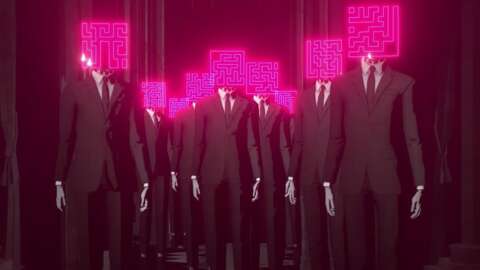
V Rising Review
The true test of a vampire game isn’t so much in the ways it lets you do the cool things vampires do – it’s in how it portrays the classic vampire weaknesses, forcing you to live a vampire lifestyle. V Rising does a pretty good job of this, with banes from sunlight to garlic represented, while also featuring a striking and memorable art style alongside exciting and tough ARPG combat. Many of the gripes I had in my Early Access review have been addressed without changing the heart-pounding identity of the experience, especially when playing in a customized single-player world.
As a newly-resurrected vampire in a world where humans have mostly chased your kind into the shadows, this mashup of Diablo and the survival crafting genre doesn’t spend a lot of time on up-front storytelling. The descriptions for its varied bosses give some sense of how the world is put together, but there’s not really a main plot to follow until much later. You build a blood altar, you get a list of special enemies you need to kill to unlock new abilities and better technologies, and you’re off on the hunt. This doesn’t bother me too much, and I did enjoy piecing together how little bits of lore were connected, discovering new areas and factions along the way.
In Early Access, I had a hard time with the amount of resource gathering and waiting around for ore to smelt that you had to do. But with 1.0’s extensive game setup customization, I found that I could dial things like resource yields and crafting speed in to the point where there was really no drudgery involved at all. Some high tech recipes still take longer than I’d like to finish, but there is generally always something rewarding I can be doing while I wait, so it’s not that big of a deal.
Designing and detailing your massive vampire castles can be highly entertaining. On a private server, they can be built up to six stories high, with a huge variety of functional and cosmetic items to unlock – from eerie, floating candelabras to a hungry treasure chest that recycles unwanted items into their component materials. You do have to continue feeding your castle blood essence to keep it active, which comes from just about any enemy you kill. This isn’t much of an issue in an offline game since essence will only be consumed when you’re playing, and you can save up hundreds of real-world days’ worth, so you’re unlikely to ever run out. But on a public server, depending on its settings, your castle could eventually crumble or even be captured by enemy players, causing you to lose that spot on the map if you don’t log in at least once or twice a week to top it off. That can start to feel like a chore after a while.
You’re never splitting hairs between 12 versions of the same axe.
I’m also a little bit disappointed that my castle couldn’t have a basement. Especially when I started imprisoning foolish mortals to use as blood cattle – what? Don’t look at me like that. I longed for the ability to stick them underground in an elaborate dungeon, but had to settle for an above-ground jail.
The other welcome addition since Early Access that cuts back on the downtime of building and crafting is Rift Incursions, which are timed events that pit you against a unique roster of enemies to earn Stygian Shards, which play into a new mid-to-late-game progression system. Among other things, they let you craft more powerful versions of all the base weapons using ruined weapon templates, which can be bought or found in random drops, with modifiers that can vary in strength.
This adds a little bit more of a feeling of personalized loot and progression without being overly random. You’re never going to be splitting hairs between 12 different versions of the same axe, which would have been a bit too much Diablo for me. But there is a reason to keep hitting up rifts if you want the absolute best gear for your build, which is nice.
The fast-paced but deliberate ARPG combat is the star of V Rising, and it’s honestly some of the best in the genre today. The broad array of flashy, fun, and deadly active abilities to unlock allow for some awesome builds. I particularly liked the Blood tree, which focuses on healing yourself throughout battle. I would have appreciated a stamina bar or more ways to get additional combat dashes, because basically everything is cooldown-based, and it can feel really bad in those moments when you don’t have any buttons to push. I prefer more fine-grained resource management and builder-spender combat, myself. But it also encourages you to think carefully about when to deploy your defensive and movement abilities, which keeps bigger fights from feeling too button-mashy.
The more than 50 challenging bosses are really the highlight of V Rising. From zealous human hunters to creepy necromancers, no two feel alike in fighting style or personality, and almost all are very well-designed encounters. The later ones can be cleverly and mercilessly difficult, which is generally a good thing. My main criticism is that some of them feel like they have too many defensive and area denial abilities, to the point that you don’t get enough opportunities to attack them in melee. I can switch to my pistols, sure, but I prefer to slice my food to pieces. Luckily, each one has a fairly unique set of tricks, so it never feels like V Rising is leaning on one thing too much to dial up the challenge.
The survival mechanics really sell the vampire fantasy.
I really like the art direction overall. It’s a bit stylized and cartoony, but not in a way that detracts from the horror aspects. Whether I’m exploring a misty, haunted forest, slashing my way through a skeleton-infested graveyard, or sneaking into a pastoral human village – bundled head-to-toe in rags, which isn’t suspicious at all – everything is very readable and eye-catching. It’s never a pain to figure out what’s going on in combat, and the environment artists have made great use of color to create a range of moods and vibes. This is only helped by the soundtrack, which does generally fit what I’d call stereotypical vampire music – all mournful strings and melodramatic piano melodies – but it’s executed well.
The survival mechanics really sell the vampire fantasy, too. There is a full day/night cycle, and standing in the sun will start to drain your health quickly after a short grace period. Moving about by day is still fully possible if you’re careful, thanks to the fact that anything that casts a shadow in the environment can serve as a safe haven, including passing clouds. That’s a really cool touch. Shadows even shift throughout the day, so noon is a more dangerous time to be outside than dawn or dusk.
Keeping your blood supply topped up is also appropriately essential, as it’s your main way of healing outside of combat. What’s even better is that the blood type of the last enemy you fed on temporarily gives you a character class, which comes with handy bonuses like increased critical chance for rogues or damage resistance for brutes. How much of a bonus is based on the Blood Quality of your victim, which is semi-randomized and encourages you to seek out particularly tasty prey. I enjoyed how this system let me customize my fighting style on the fly and encouraged me to act like a discerning hunter.
There are also rich options for multiplayer, for everything from building a big castle in a private world with a few of your friends, to PvP free-for-alls with capturable castles and siege golems. I personally prefer the former. But even on public servers, I found a lot of the issues with balance in Early Access – like all of the good plots of land being taken, making the whole world feel like more of a Gothic suburb – have been alleviated quite a bit. The official servers have been very stable during the beta as well. I never felt like I lost a duel because of weird ping or anything like that.







